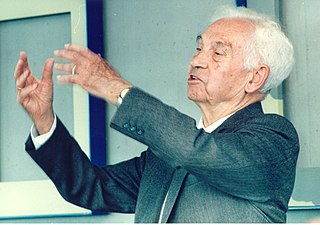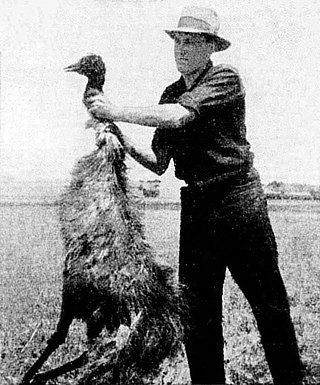Related Research Articles

Ernst Walter Mayr was a German-American evolutionary biologist. He was also a renowned taxonomist, tropical explorer, ornithologist, philosopher of biology, and historian of science. His work contributed to the conceptual revolution that led to the modern evolutionary synthesis of Mendelian genetics, systematics, and Darwinian evolution, and to the development of the biological species concept.

The Emu War was a nuisance wildlife management military operation undertaken in Australia over the later part of 1932 to address public concern over the number of emus said to be destroying crops in the Campion district within the Wheatbelt of Western Australia. The unsuccessful attempts to curb the population of emus employed Royal Australian Artillery soldiers armed with Lewis guns—leading the media to adopt the name "Emu War" when referring to the incident. Although many birds were killed, the emu population persisted and continued to cause crop destruction.

The Royal Australasian Ornithologists Union (RAOU), now part of BirdLife Australia, was Australia's largest non-government, non-profit, bird conservation organisation. It was founded in 1901 to promote the study and conservation of the native bird species of Australia and adjacent regions, making it Australia's oldest national birding association. In 1996, the organisation adopted the trading name of Birds Australia for most public purposes, while retaining its original name for legal purposes and as the publisher of its journal, the Emu. In 2012, the RAOU merged with Bird Observation & Conservation Australia to form BirdLife Australia.

John Albert Leach was an ornithologist, teacher and headmaster in the state of Victoria, Australia.
Dominic Louis Serventy was a Perth -based Western Australian ornithologist. He was president of the Royal Australasian Ornithologists Union (RAOU) 1947–1949. He assisted with the initial organisation of the British Museum's series of Harold Hall Australian ornithological collecting expeditions during the 1960s, also participating in the third (1965) expedition.
John Casimir Zichy Woinarski is an Australian ornithologist, mammalogist, and herpetologist. He was awarded the 2001 Eureka Prize for Biodiversity Research. In the same year he was the recipient of the D. L. Serventy Medal, awarded by the Royal Australasian Ornithologists Union for outstanding published work on birds in the Australasian region.
Clive Dudley Thomas Minton, AM was a British and Australian metallurgist, administrator, management consultant and amateur ornithologist. His interest in birds began in childhood.
George Mack (1899-1963) was mainly a museum ornithologist and collector, but also worked as an ichthyologist. He migrated from Britain to Western Australia in 1919. He worked at the National Museum of Victoria from 1923 to 1945. During this time, he published a revision of the Australian species of the fairy-wren genus Malurus and described several species of fish, for example Galaxiella pusilla. He then worked at the Queensland Museum from 1945, rising to become director in 1963, the year of his death. It was his controversial action in shooting a scarlet robin during the Royal Australasian Ornithologists Union (RAOU) campout in Marlo, Victoria in 1935 that catalysed change in the RAOU's attitude to collecting.
Dr. Glen Milton Storr was an Australian ornithologist and herpetologist. He joined the Western Australian Museum in 1962 and became curator of ornithology and herpetology in 1965. He was a member of the Royal Australasian Ornithologists Union (RAOU), and served as secretary of the Western Australian Branch of the RAOU in 1954.
Professor Jiro Kikkawa was a Japanese Australian ornithologist. His early zoological studies were at Tokyo University, Japan and at Oxford University in England. He subsequently spent three years at the University of Otago in New Zealand where he began what was to become an enduring focus of research, the behavioural ecology of Silvereyes and other species of Zosterops.
Dr Hugh Alastair Ford is an Australian ornithologist.
Richard Alexis Zann was an Australian ornithologist.
Michael Stanley Reid Sharland (1899–1987) was an Australian journalist, photographer, author and amateur ornithologist. He was born, and spent most of his life, in Tasmania, though he also lived and worked in Sydney, Melbourne and London.

Whipbirds and wedgebills are collectively recognised in the genus Psophodes. Wedgebills are divided into the chirruping wedgebill and the chiming wedgebill. Whipbirds are divided into the eastern whipbird and the western whipbird. Subspecies of the western whipbird residing in Western Australia are known to be endangered. Psophodes is a genus of five species of songbirds endemic to Australia, known as whipbirds and wedgebills.

The western yellow robin is a species of bird in the Australasian robin family, Petroicidae, native to Australia. Described by John Gould in 1838, the western yellow robin and its Australian relatives are not closely related to either the European or American robins, but they appear to be an early offshoot of the Passerida group of songbirds. Ranging between 13.5 and 15.5 cm long, it has grey upperparts, and a grey breast and head, broken by whitish streaks near the bill and below the eye, with a conspicuous yellow belly. The sexes are similar in appearance. Two subspecies are recognized: subspecies griseogularis, which has a yellow rump, and subspecies rosinae with an olive-green rump.

The western gerygone is a small, brownish-grey species of passerine bird, which is found in inland and south-west Australia. It is an arboreal, insectivore of open forest, woodland and dry shrubland. It is not currently threatened with extinction.
Leslie Christidis, also simply known as Les Christidis, is an Australian ornithologist. His main research field is the evolution and systematics of birds. He has been director of Southern Cross University National Marine Science Centre since 2009. He was assistant director at Sydney's Australian Museum from 2004 to 2009.
The Kimberley honeyeater is a bird in the honeyeater family, Meliphagidae. It was formerly lumped with the white-lined honeyeater but, based on a genetic analysis, it is now considered a separate species. Articles published in 2014 and 2015 provided evidence that the Kimberley and white-lined honeyeaters differ not only genetically, but also in song and foraging ecology. The specific epithet honours the Australian chemist and ornithologist Dr Julian Ralph Ford (1932-1987).
James David Macdonald FLS FZS FIB was a Scottish-Australian ornithologist and ornithological writer. A traditional museum ornithologist, he did much to build up the collections of African and Australian birds held by the British Museum, as well as popularising ornithology through his writings.

Frederick Bulstrode Lawson Whitlock (1860-1953) was an ornithological writer and oölogist, active in England and across Western Australia.
References
- ↑ Beolens, Bo; Watkins, Michael; Grayson, Michael (2011). The Eponym Dictionary of Reptiles. Baltimore: Johns Hopkins University Press. xiii + 296 pp. ISBN 978-1-4214-0135-5. ("Ford, J. R.", p. 92).